Abstract
We explored sociolectic differences in color lexicon of Russian speakers. The study aim was twofold: (I) to investigate the influence of growing competence in individuals professionally working with color (henceforth: “color professionals”) on the pattern of color names and (ii) to compare color-naming patterns in groups of participants with different levels of professional competence (beginner, intermediate, and advanced). For intergroup comparison, we employed the following indices: (1) frequency of occurrence of recurring color terms; (2) number of words in color descriptors; (3) occurrences of basic color terms (BCTs), monolexemic nonBCTs, and polylexemic BCT-derivatives; and (4) the scope of objects used as color-term referents. An unconstrained color-naming method was used in an online experiment, with total 600 standardized color stimuli presented across respondents. Final dataset contained 48,687 responses of 1,737 native Russian speakers (1,204 females, 526 males), with different levels of color expertise and aged between 16 and 95 years. Results show that both color vocabulary and linguistic patterns of naming color change considerably with respondents' increasing professional experience and expertise. Specifically, the growing color competence is reflected in advanced specificity of naming colors; prevalence of complex patterns of color descriptors that contain greater number of nonBCTs, along with BCTs; greater variety of modifiers and emotionally-laden linguistic components, and professionally-specific object referents, such as dyes, pigments and paint brand names.
Keywords: Color educationcolor namingRussianprofessional competenceprofessional culturesociolectic differences in color lexicon
Introduction
The Russian language possesses rich and nuanced inventory of color terms – the focus of abundant anthropologic, linguistic, and psycholinguistic studies (Apresjan, 2018; Astakhova, 2014; Bimler & Uusküla, 2017; Kalita, 2017; Kezina & Perfilova, 2017; Moss, Davies, Corbett, & Laws, 1990; Paramei, Griber, & Mylonas, 2018; Shchitova, Shchitov, & Hua, 2018; Stefanov, 2015; Uusküla & Bimler, 2016). Across languages, studies provided evidence that richness and linguistic refinement of the color-term vocabulary differs markedly among representatives of various social and demographic groups.
In particular, gender differences have been demonstrated in numerous studies comparing male and female color lexicons (for recent reviews see: Mylonas, Paramei, & MacDonald, 2014; Paramei et al., 2018). It was found that women have a more extensive color vocabulary than men. Also, in addition to basic color terms (BCTs), women utilize significantly more specific color terms – BCT hyponyms, elaborate and “fancy” color terms, whereas men often employ combinations of BCTs with lightness or saturation adjectives (see e.g., Simpson & Tarrant, 1991; Lindsey & Brown, 2014).
Also observed was inter-generational variation of color lexicon: informants of various age groups differ in the number of specific color names compared to nonspecific ones (Simpson & Tarrant, 1991), with older women and men manifesting richer color lexicon than young representatives of their sex (Ryabina, 2009; Samarina, 2007). Moreover, specific color terms of females, in some Caucasian endogenous cultures, were found to reflect familiar objects in their environment, such as fruits, vegetables, plants, semiprecious stones etc., compared to more abstract males’ terms (Samarina, 2007).
Problem Statement
Sociolectic differences in color naming indicated above are largely attributed to life experience and, as well, to the influence of the material culture and individual’s professional environment (professional education and competence, professional culture). Simpson and Tarrant (1991) argue that if men have a profession or hobby related to color, they usually know more color names. Indeed, a positive relationship between male speakers' color-related hobbies and the size of their color vocabulary was demonstrated for speakers of English (Swaringen, Layman, & Wilson, 1978) and Chinese (Yang, 2001). Furthermore, in a group of male (Udmurt) respondents, professional education was found to play a significant role in the size of color lexicon: painters and specialists in Udmurt language used many more color terms than other groups (varying in age and sex), producing fancy and idiosyncratic words (Ryabina, 2009). Interestingly, in all these studies females’ (richer) color vocabulary was found to be independent of their professional education or hobbies.
In comparison, differences in individual color lexicons in relation to varying levels of professional color competence remain unexplored. More generally, it was found and is commonly agreed that, in the process of explicit, implicit and “informal” professional development (cf.: Evans, 2019), professional environment – education and culture – molds an individual’s mind resulting in specific ways of thinking, or “habits of mind” (e.g., Chick, Haynie, & Gurung, 2012, p. 2). To our knowledge, no systematic exploration has been undertaken of the influence of occupation and/or professional color competence on color-naming pattern or size and/or specific characteristics of color vocabulary.
Research Questions
In the present study we addressed the question of sociolectic differences in color lexicon in Russian native speakers.
Purpose of the Study
The aim of the study was twofold: (I) to investigate influence of experience in individuals working professionally with color (henceforth: “color professionals”) on the pattern of color names and (ii) to compare this in groups of participants with different levels of professional competence (beginner, intermediate, and advanced). The intergroup comparison employed the following indices: (1) frequency of occurrence of recurring color terms; (2) number of words in color descriptors; (3) occurrences of BCTs, monolexemic nonBCTs, and BCT-derivatives; and (4) the scope of objects used as color-term referents.
Research Methods
Design of the web-based experiment procedure
An online data gathering technique was used in the study. Data were collected in a web‐based color-naming experiment (Web‐based color-naming experiment, n. d.), designed and developed in Adobe Flash CS4 S.V. and ActionScript 3 (Mylonas & MacDonald, 2010). The Flash applet was embedded in HTML and connected via PHP bridges to a mySQL database that sent the test images (color stimuli) in a random order and, in return, stored the information for each participant.
The experimental procedure consisted of six steps (Mylonas & MacDonald, 2010, 2016). First, observers were asked to adjust their display to RGB settings and adjust brightness, so that all 11 steps of a grayscale ramp were visible. In the second step, participants answered questions relating to the ambient lighting conditions, their environment, and display properties. In the third step, participants were screened for possible color-vision deficiency using a web‐based Dynamic Color Vision Test developed at the City University London (Barbur, 2004). The next, fourth and main part was the unconstrained color-naming (UCN) task: any color descriptor in Russian, either a single word, or a compound, or term(s) with modifiers could be produced to name each of presented color samples. In the fifth step, information about the participant's residency, nationality, language proficiency, educational level, age, gender, and color competence was collected. In the final step, participants were provided with a summary of their responses and a “Communication Form” for comments.
The experiment required approximately 15 minutes to complete.
In the reported results below, the elicited Russian color names are transliterated into Latin letters using a free online transliterator (Online Transliterator, n. d.).
Color stimuli
Each participant was presented, in random order, with a sequence of 20 colors selected from the total of 600 samples in the Munsell Renotation Dataset (Figure
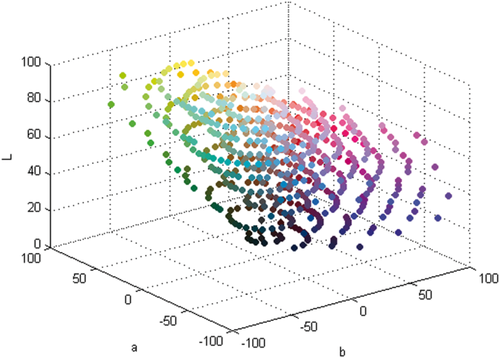
Participants
In total, 2,457 respondents took part in the web-based experiment and produced 55,818 color descriptors of the 600 samples. In the process of data cleaning, we removed responses of participants who indicated that they do not live or were not raised in Russia, as well as responses of those, who had not indicated their competence in working with color. We also excluded all color names entered using non-Cyrillic alphabet, as well as irrelevant comments (e.g., “I’m so tired” or “Stop it!”) or inconsistent and numerical responses.
This filtering resulted in a dataset containing 48,687 responses of 1,737 native Russian speakers (1,204 females and 526 males). Their age ranged from 16 to 95 years with mean age 41.36 years. With regards to the education level, 21.8% participants reported secondary school degree; other reported a Bachelor (28.8%), Master's (18.2%), Doctoral (7.7%), or Professional (18.5%) degree.
The respondents reported different levels of color competence: 63.5% participants described their competence as that of beginners; 29.3% reported an intermediate level; and 7.2% indicated that they were color professionals. None of the respondents reported problems with color vision.
The sample characteristics are presented in Table
Findings
The refined dataset contained 2,403 unique color descriptors. Table
Frequency of color names
To begin with, we compared frequency of recurring color names in the three color-competence-groups. The first 26 most frequent color names were similar in all three groups, although the name ranking differed slightly (see Figure
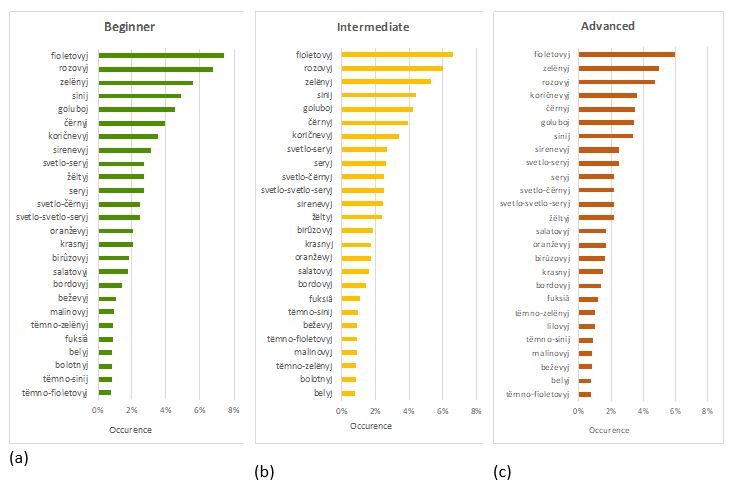
Number of words in color descriptors
The proportion of elicited BCTs was found to decrease with advancement in color competence: the beginners produced more BCTs (47%) than color professionals of both the intermediate (43%) and advanced level (37%) (Figure
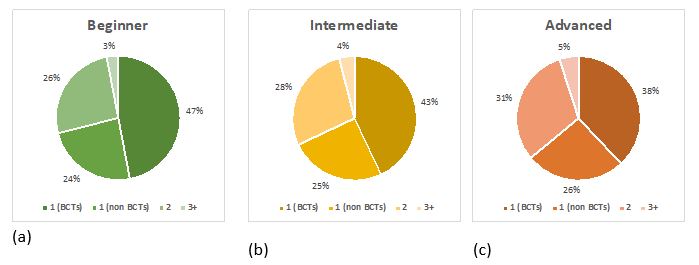
Occurrence of the 12 Russian BCTs
In spite of the unconstrained method of color naming employed in the experiment, (unmodified) basic color terms were produced very frequently by all participants totalling to 45%. Although the pattern of relative usage of individual BCTs was similar across all three groups (Figure
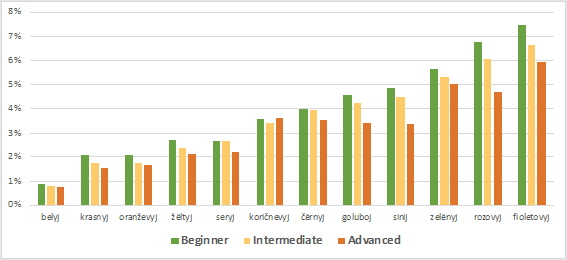
Derivational productivity of the 12 Russian BCTs
Along with the BCTs, all respondents frequently also offered various BCT-derivatives – BCT compounds and combinations of BCTs with modifiers or object glosses (Figure
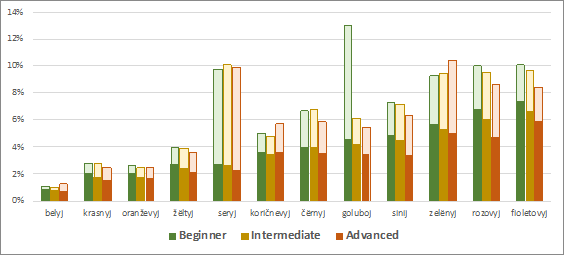
The inventory of names derived from the BCTs varied significantly in both the total number of unique polylexemic descriptors and the frequency of the descriptor occurrence. Furthermore, the BCT-derivatives were produced using the following four patterns (cf.: Simpson & Tarrant, 1991; Rakhilina & Paramei, 2011):
(1)
(2)“
(3)
(4)
Notably, compared to the beginners, both color professional groups used less frequently the CB pattern (4), i.e., complex unconventional, idiosyncratic compounds or collocations with BCTs, but more often the HMB pattern (3), i.e., combinations of BCTs with various hue-modifying nonBCTs (Figure
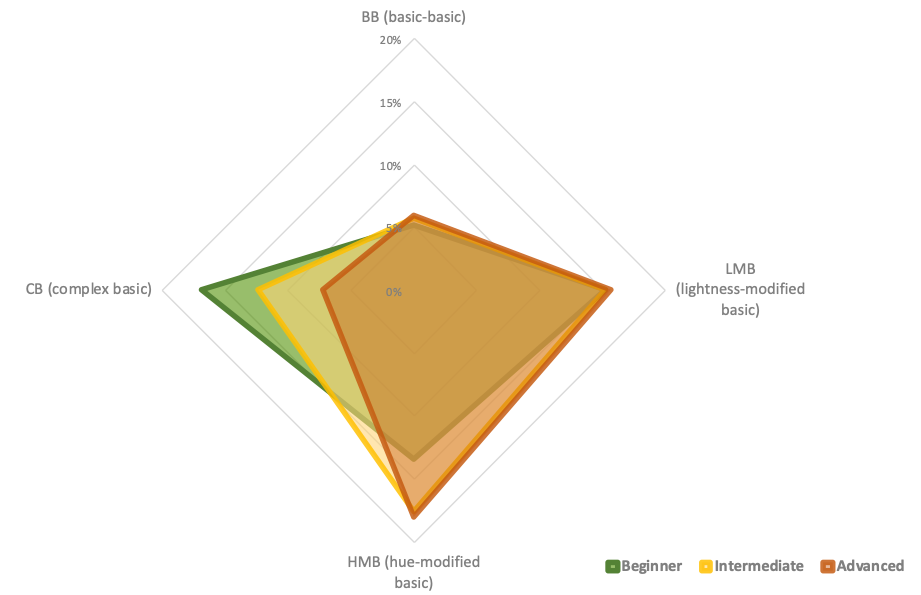
In describing stimuli, color professionals used complex patterns with components, which were entirely absent in the beginners’ lexicon; namely, the former used expert-specific notions referring to technical aspects of dye and pigment production, or paint brands (like Camel, Moveyn, Safari, Serenity, etc.), and exotic terms appearing in modern advertisements. Furthermore, in color professionals’ descriptors fairly common were expressions such as:
Occurrence and “valency” of achromatic modifiers
The variety of color descriptors also revealed a wide range of different achromatic modifiers, the majority of which are commonly used by Russian speakers. In all three groups, the highest usage frequency was of lightness modifiers
Furthermore, across all participants’ descriptors, certain achromatic modifiers revealed comparable “valency”, that is, by analogy with chemistry, high potential to form compounds and collocations with color terms (cf.: Kezina & Perfilova, 2017). Particularly productive appeared modifiers
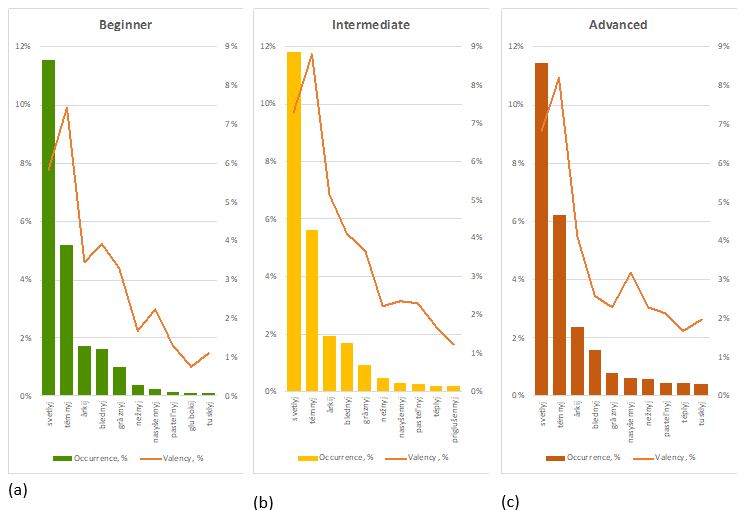
Object-derived color names
A significant number of color terms (28.95%) were derived from names of objects. In the present dataset, we found that both the catalogue of objects used as color-term referents and the frequency of occurrence of object-derived color names increased with color expertise (Figure
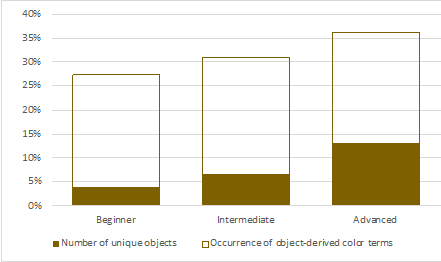
In our analysis, we focused on 30 categories of objects functioning as color‐term referents (Table
1.
2.
3.
4.
5.
6.Body and bodily products.
For the beginners, among the most common object categories as color‐term referents were natural substances, plants, flowers, artefacts, and bodily substances. Color professionals, in addition, frequently referred to paint brands or exotic terms appearing in modern advertisements, as well as to specific dyes and pigments (Figure
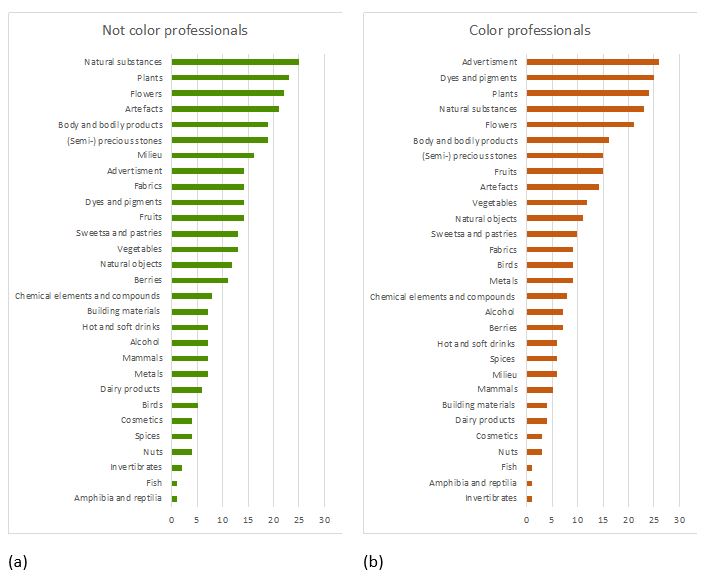
The number of objects used as color‐term referents constitute a significant number in inventories of all respondents, wit: 301 objects offered by the color professionals, compared to 320 objects offered by the beginners.
Although the number of object referents is only slightly greater for the beginners, the inventories vary substantially between them and color professionals (see Table
Models “cveta X” and “X”
To name the color stimuli, color professionals more frequently than the beginners implemented two specific models of formation of object‐derived color terms:
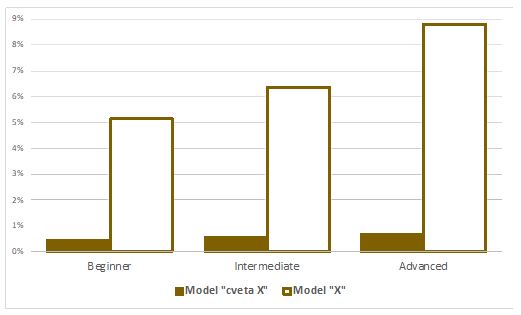
Conclusion
Our study demonstrated that color vocabulary and linguistic patterns of naming color considerably change with respondents' increasing color competence.
Participants with no professional color competence reveal lexical shortage of color terms for a large number of nonprototypical colors (“no man’s land” of color space), the shortage they appear to circumvent by employing idiosyncratic comparisons (e.g., with a cartoon car, pink elephant, Pink Panther, Winnie the Pooh) or random associations with objects that they probably are observing in their immediate environment during the experiment (e.g., a blanket, platter, floor). Further, along with naming the color as such, nonexperts frequently accompany color names by an innocent emotional and/or aesthetic appraisal of color by using descriptors such as
In comparison, advanced color competence is reflected by increase in specificity of naming colors, as well as by complex patterns of BCTs with a greater number of nonBCTs and greater variety of modifiers, and in using emotionally-laden components. Crucially, the evolving color competence is reflected in color-descriptor components that refer to technical aspects of dye or pigment production, as well as in emergence of naming patterns containing professionally-specific object referents, such as dyes, pigments, and brand names of paints surfacing in modern advertisements.
The influence of professional education and professional culture is most clearly manifested in the choice of specific referent objects alluded to in color descriptions. This is illustrated by color descriptors of chemists who participated in the experiment: for naming various shades, they frequently denoted colors of various chemical elements and compounds rarely used in everyday communication (e.g., chromium oxide, sulfur, cobalt, cadmium, etc.), and, in our dataset, were not found among responses of participants from other professional fields. In the same vein, biologists and medical practitioners compared color shades with those of different body secrets (e.g., snot, bile), with those observed in laboratory reactions (e.g., hemagglutination), or caused by damage to body tissues (e.g., burn, hypothermia, cadaverous stains).
Furthermore, more often than beginners, color professionals used the models “X” and “color of X”. Both models are not widespread, from the view point of Russian word-formation norms (cf.: Rakhilina, 2000, 2007). The model “X” appears to have emerged in Russian very recently, under the influence of English (where it is the norm) in the process of trade globalization (cf.: Paramei, et al., 2018). The model “color of X” is commonly used in cases, when, to “capturing” linguistically, the color of a transient, short-lived event (“X”), unconventional, idiosyncratic, or exotic terms are used (Rakhilina, 2000, 2007). We observe that color professionals used both models as a way to create new, emotionally expressive color terms (e.g.,
The vocabulary of color professionals contains fewer BCTs, and BCT-derivatives that they use are predominantly hue modified ones, in the form of adjective constructions with color terms built according to the model “
Such adjectival constructions suggest an interesting way of color-descriptor production at color category boundaries or in color-space “no man’s land”. Specifically, in the minds of native speakers, the spectrum is not just divided into non-overlapping percepts corresponding to particular wavelength ranges, but is represented by a range of cognitive entities, or abutting color categories with graded membership of their denotata (Douven, Wenmackers, Jraissati, & Decock, 2017). Therefore, color terms at category boundaries may have not one, but several competing meanings, which, in communication, are specified by the term’s combination with modifiers or compounds (cf.: Rakhilina, 2000, 2007). Due to the chosen components in the adjectival construction, interaction of their meanings triggers semantic flows that are likely to mediate the color percept – as a specific case of perception penetrated by cognition.
Acknowledgments
YAG was funded by the Russian Foundation for Basic Research, Grant Number: 17‐29‐09145. The authors gratefully acknowledge support of Dimitris Mylonas, who has developed the online color-naming platform and advised on analysis of the color-descriptor indices. Appreciated is also help of Tatjana A. Samoilova in data filtering.
References
- Apresjan, V. (2018). Russian constructions with syntactic reduplication of colour terms: A corpus study. Russian Journal of Linguistics, 22(3), 653-674.
- Astakhova, J. A. (2014). Cvetooboznačenija v Russkoj Jazykovoj Kartine Mira [Color Terms in Russian Linguistic Worldview]. PhD Thesis. Moscow: Moscow State Pedagogical University [in Rus.].
- Barbur, J. L. (2004). “Double‐blindsight” revealed through the processing of color and luminance contrast defined motion signals. Progress in Brain Research, 144, 243-260.
- Bimler, D., & Uusküla, M. (2017). A similarity‐based cross‐language comparison of basicness and demarcation of “blue” terms. Color Research and Application, 42(3), 362-377.
- Chick, N. L., Haynie, A., & Gurung, R. A. R. (2012). Exploring More Signature Pedagogies: Approaches to Teaching Disciplinary Habits of Mind. Sterling: Stylus.
- Douven, I., Wenmackers, S., Jraissati, Y., & Decock, L. (2017). Measuring graded membership: The case of color. Cognitive Science, 41(3), 686-722.
- Evans, L. (2019). Implicit and informal professional development: What it ‘looks like’, how it occurs, and why we need to research it. Professional Development in Education, 45(1), 3-16.
- Griber, Y. A., Mylonas, D., & Paramei, G. V. (2018). Objects as culture-specific referents of color terms in Russian. Color Research and Application, 43(6), 958-975. doi:
- Kalita, I. (2017). Ocherki po Komparativnoj Frazeologii II. Cvetnaja Palitra v Nacional'nyx Kartinax Mira Russkix, Belarusov, Ukraincev i Chekhov [Essays on Comparative Phraseology II. Color Palette in National Worldviews of Russians, Belarusians, Ukrainians, and Czechs]. Ústí nad Labem: PF UJEP [in Rus.].
- Kezina, S. V., & Perfilova, M. N. (2017). Dinamika valentnosti cvetooboznačenij v istorii russkogo jazyka [Valency dynamics of color terms in history of Russian]. Liberal Arts in Russia, 6(1), 67-81 [in Rus.].
- Kudria, O. A. (2015). Leksiko-semantičeskaja klassifikacija vtoričnyx cvetooboznačenij v anglijskom i ukrainskom jazykax: Lingvokul'turologičeskij aspekt [Lexico‐semantic classification of secondary color terms in English and Ukrainian: A linguo-culturological aspect]. Russian Language Studies, 1, 53-59 [in Rus.].
- Lindsey, D. T., & Brown, A. M. (2014). The color lexicon of American English. Journal of Vision, 14(2),17, 1-25.
- Moss, A., Davies, I., Corbett, G., & Laws, G. (1990). Mapping Russian basic colour terms using behavioural measures. Lingua, 82(4), 313-332.
- Mylonas, D., & MacDonald, L. (2010). Online colour naming experiment using Munsell colour samples. In Proceedings of the 5th European Conference on Colour in Graphics, Imaging, and Vision (CGIV) (pp. 27-32). Springfield: IS&T.
- Mylonas, D., & MacDonald, L. (2016). Augmenting basic colour terms in English. Color Research and Application, 41(1), 32‐42.
- Mylonas, D., Paramei, G. V., & MacDonald, L. (2014). Gender differences in colour naming. In W. Anderson, C. P. Biggam, C. A. Hough, & C. J. Kay (Eds.), Colour Studies: A Broad Spectrum (pp. 225-239). Amsterdam/Philadelphia: John Benjamins.
- Online Transliterator (n. d.). Retrieved from http://translit.cc/.
- Paramei, G. V., Griber, Y. A., & Mylonas, D. (2018). An online color naming experiment in Russian using Munsell color samples. Color Research and Application, 43(3), 358-374.
- Rakhilina, E. V. (2000). Kognitivnyj Analiz Predmetnyx Imën: Semantika i Sočetaemost’ [Cognitive Analysis of Object Names: Semantics and Collocations]. Moscow: Russkie Slovari [in Rus.].
- Rakhilina, E. V. (2007). Linguistic construal of colors: The case of Russian. In R. E. MacLaury, G. V. Paramei, & D. Dedrick, (Eds.), Anthropology of Color: Interdisciplinary Multilevel Modeling (pp. 363-377). Amsterdam/Philadelphia: John Benjamins.
- Rakhilina, E. V., & Paramei, G. V. (2011). Colour terms: Evolution via expansion of taxonomic constraints. In C. P. Biggam, C. A. Hough, C. J. Kay, & D. Simmons (Eds.), New directions in colour studies (pp. 121–131). Amsterdam/Philadelphia: John Benjamins.
- Ryabina, E. (2009). Sex-related differences in the colour vocabulary of Udmurts. WEBFU [Wiener elektronische Beiträge des Instituts für Finno-Ugristik]. Retrieved from http://webfu.univie.ac.at/texte/12Ryabina.pdf
- Samarina, L. V. (2007). Gender, age, and descriptive color terminology in some Caucasus cultures. In R. E. MacLaury, G. V. Paramei, & D. Dedrick, (Eds.), Anthropology of Color: Interdisciplinary Multilevel Modeling (pp. 457-466). Amsterdam/Philadelphia: John Benjamins.
- Shchitova, O. G., Shchitov, A. G., & Hua, K. (2018). Kognitivnoe modelirovanie cvetooboznačenij v russkom i kitajskom jazykax [Cognitive modeling of color naming in Russian and Chinese]. Tomsk State Pedagogical University Bulletin, 6(195), 81-85 [in Rus.].
- Simpson, J., & Tarrant, A. W. S. (1991). Sex‐ and age‐related differences in colour vocabulary. Language and Speech, 34(1), 57-62.
- Stefanov, S. I. (2015). Nazvaniâ cveta i ego ottenkov. Tolkovyj slovar'‐spravočnik. Bolee 2000 terminov s anglijskimi èkvivalentami [Names of Colors and Their Shades: The Explanatory Dictionary with Definitions. More than 2000 Terms with English Equivalents]. Moscow: LENAND [in Rus.].
- Swaringen, S., Layman, S., & Wilson, A. (1978). Sex differences in color naming. Perceptual and Motor Skills, 47(2), 440-442.
- Uusküla, M., & Bimler, D. L. (2016). From listing data to semantic maps: Cross‐linguistic commonalities in cognitive representation of color. Folklore, 64, 159-180.
- Web‐based color-naming experiment (n. d.). Retrieved from https://colornaming.net/lang/ru
- Yang, Y. (2001). Sex and language proficiency level in color-naming performance: An ESL/EFL perspective. International Journal of Applied Linguistics, 11(2), 238-256. https://doi.org/10.1111/1473-4192.00016
Copyright information

This work is licensed under a Creative Commons Attribution-NonCommercial-NoDerivatives 4.0 International License.
About this article
Publication Date
02 December 2019
Article Doi
eBook ISBN
978-1-80296-072-3
Publisher
Future Academy
Volume
73
Print ISBN (optional)
-
Edition Number
1st Edition
Pages
1-986
Subjects
Communication, education, educational equipment, educational technology, computer-aided learning (CAL), Study skills, learning skills, ICT
Cite this article as:
Griber, Y. A., & Paramei, G. V. (2019). The Influence Of Professional Color Competence On Color Lexicon And Naming Pattern. In N. I. Almazova, A. V. Rubtsova, & D. S. Bylieva (Eds.), Professional Сulture of the Specialist of the Future, vol 73. European Proceedings of Social and Behavioural Sciences (pp. 647-663). Future Academy. https://doi.org/10.15405/epsbs.2019.12.69
